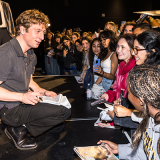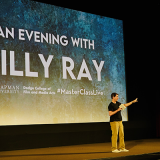Stunt Class Update – Guest Cinematographer Steven Bernstein
January 8, 2011
Early this week, Steven Bernstein (many-hat-wearing director of photography for Monster, Underworld, and Half Baked to name a few), spoke to students in the Folino covering a wide range of topics from how to work with crews, keep narcissism in check, how to overcome onset fears of all kinds, and recounted some very funny stories about his own experiences on high-budget Hollywood sets. He's a very funny man, and a great storyteller, recounting hilarious misadventures of set anarchy gone wrong, being tackled by a director who panicked at the last minute before a shoot, jammed prop guns and other dangerous situations.
While much of his advice was tailored for film students, and cinematographers in particular, this is good advice for anyone looking to start a career in an industry where large teams of people are held to impossible deadlines and under intense scrutiny.
PR/A students: sound like anyone you know?
Steven Bernstein's general advice on how to get work done:
- "Narcissism is very important to this industry" in that everyone thinks they're more important than they are!
- "This is the most important practical advice I'll give today: Apologize to everybody at the wrap party."
- "Make friends with everybody!"
- "Presume that everyone on set is equally important."
- Most people on film sets are motivated by fear: fear of failure, fear of not finishing, fear of not getting their next project funded. Nowhere is this more true than in a film set involving stunts, because unlike a normal shoot, people also begin to fear for their own safety.
- Transition this fear into a desire to "simply be the best." Choose the best shot. Select the best actors, but also give them the best direction.
- "As a creative artist, the most important thing you can do is to transcend your own fear and encourage collaborators to do the same. This is especially important in stunt scenes!"
Steven casually and thoughtfully fielded questions from a growing crowd of students after his talk with the class.

Between presenting and viewing clips of some spectacular stunt-based shots in SWAT, Bernstein also gave some general tips on how to shoot difficult scenes and answered a variety of questions from students about many different aspects of the process:
- Delved into film theory and semiotics, stressing the importance of keeping your signifiers and signifieds in mind. These, essentially, are what you mean to present on film, and how you actually portray it to the viewer. For example, in a particular scene where a helicopter crashes directly into a building, one signifier he focused on was his use of a moving camera, and how to employ it correctly to create an emotive response (fear) in the viewer.
- Pointed out the difficulty of working with directors and convincing them to shoot a scene from many, many more angles than would normally be used in a dramatic scene. For example: the helicopter scene had at least 12 cameras shooting simultaneously, of varying shutter speeds, lenses, and focus ranges.
- "We must account for set anarchy." That is, the natural tendency of things, when you need them, to not work as intended. Always roll extra cameras, use extra angles, take more safety precautions, etc, because like humans, stunts make mistakes too.
- "Don't buy all the nonsense about 'generally accepted' structures, like the 3-act script. Rules about how films and scripts are created often confuse issues and make you, as an artist, focus on the wrong things.
- "Speak the truth. Everything else will follow."
- "Some directors in Hollywood will tell you, 'all it takes is money.' But as we've seen, you could be given a $200M budget, the very best actors, the very best directors, and the very best stuntmen, and still be a complete commercial flop. This isn't always the case, but don't be surprised when the guy down the street with a $2M budget creates a film that makes history."
Specifics about the SWAT clips, showing a crashing helicopter, car chase, and shootouts:
- Tips on how to land a plane on an in-use highway.
- Generally, the accepted wisdom is to use a wide angle lens, to decrease the effect of camera vibrations.
- In contrast, Steve used short angle lenses to increase that effect, to increase the viewer's fear. It was appropriate for this particular scene's authenticity.
- Often times, when shooting and budget don't allow for 'real' props, many directors use scale models; for example, the helicopter in SWAT was actually a 3/4 scale model.
- The helicopter was rigged with large explosives throughout.
- The glass pane it crashes into was actually sugar glass [You can make it yourself! -JP], and was rigged with very small explosive charges, causing it to shatter explosively.
- But these two elements would have failed if not rigged to explode simultaneously, in a very specific timeframe (not exactly simultaneous; accounting for the physics of explosions sounds like a science of its own).
- The scene was shot with a total of 10 cameras, for example one shooting slow motion, to exaggerate the shattered glass effect, ones from above, below in a manhole, various angles inside the building, etc. "This shot had the fewest cameras of any scene in the movie. All the rest of them had even more."
- Do the stunt first, then get the actors in later. Actors hate it, but it's a lot easier to adjust the performance based on how a stunt goes, than to try to match where an actor wants his line of sight to be, for example.
And answered, in detail, some very relevant questions from students:
- How did you shoot the explosions at such fast frame rates while catching all the detail of the action?" — "Two simple answers: we use film cameras. They have a much wider tolerance for capturing light effects than digital cameras, and is much more important than their makers would have you believe. If you don't have that option, shoot with many cameras, and composite and retouch in post."
- How do you get ground-level shots of the explosions and car crashes?" — "We contacted the City of New York, who allowed us to actually shoot from inside a manhole in the center of the street."
- How many cameras have you destroyed over your career? "Wow, (thinks for a minute)…. Many. Probably over 40? But they were often relatively cheap cameras, and the sacrifice was always worth it. In every movie where a camera was lost, it ended up making us tons of money.
- When something goes awry on a stunt shoot, how to you handle it?" — (Joking) There's a very important rule of the film business: blame somebody else. The abnegation of responsibility is an art itself." But the larger point is, you plan ahead for mistakes, so when they occur, you've already got a plan B in place to execute.
- "Politics: how to work with Hollywood?" — "Character. Every lie you tell, exaggeration you make, promise you don't keep, appointment you're late for, are all things people can measure, and determine in many ways if and how people will trust you. When they stop trusting you, you're no longer working with them. By the same token, don't be afraid to admit when you make a mistake or an oversight, because people will understand your desire to get it right. Don't be the flattering pathological liar on set. Also, get ready to work long, long hours, and always be willing to put yourself out there."
One thing I took away from Bernstein's talk was his insistence on overcoming fear, in order to accomplish your job, in order to be happy:
It's important to be able to view yourself through two lenses: one being the role you play (as a director of photography, for example) and making sure you do what is needed to get that job accomplished, but equally as important is to see yourself as a unique person with views which might conflict with the first role. And it's your job to not let narcissism and fear fracture these two selves: while you work to ensure that the director is always supported, you must always work to support yourself individually, and to make a cohesive self between them.


